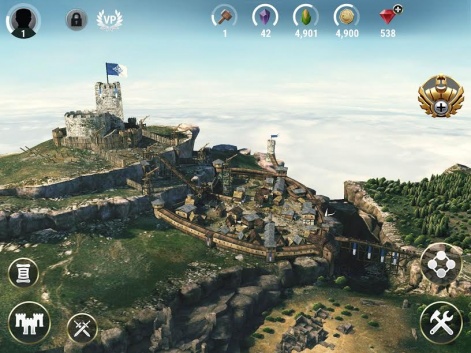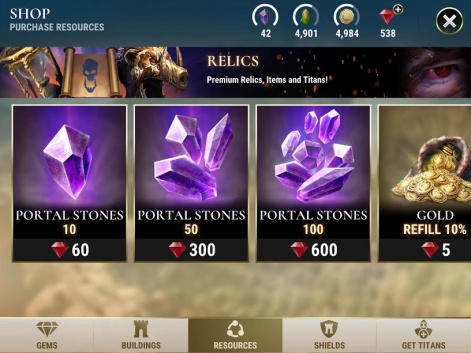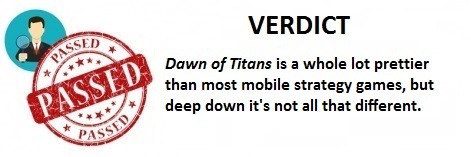Welcome back to the In-App Purchase Inspector - our regular look at free-to-play games from the consumer's perspective.
In each instalment, we consider the incentives or pressure applied to make in-app purchases, their perceived value, the expansion offered by IAPs and the overall value of the experience.
The end goal is to see whether the game makes a good enough case for us to part with our cash, or whether players are content - or engaged enough - to 'freeload'.
This time, we're taking a look at NaturalMotion's ambitious strategy title Dawn of Titans, which has finally launched globally after almost two years in soft launch.
Dawn breaks
So Dawn of Titans is finally here, answering the question 'what does a game that's spent two years in soft launch actually look like?'
The answer, predictably, is that it looks exceptionally good. Sheer graphical fidelity gives battles a sense of scale rarely seen on mobile, and performance never stutters as huge armies face off against each other.
NaturalMotion says Dawn of Titans isn't make or break, but it's hard to think of it as anything else.
But while it no doubt played a part, pure visual heft and optimised performance isn't the only reason NaturalMotion took so long readying the game for a global release.
Mobile strategy is arguably the most competitive sector in all of gaming, and a company like NaturalMotion - acquired by Zynga for $527 million back in 2014 - knows full well that making a hit is no easy task.
The studio's CEO Torsten Reil may be keen to assert that Dawn of Titans is not a make or break game for the studio, but it's hard to think of it as anything else after a development and soft launch period that saw it elevated to near-mythical status.
Clean slate
Then again, I suspect that this all holds far more significance to those of us in and around the mobile games industry than your average mobile gamer.
And for the majority, Dawn of Titans will simply be an extremely good-looking strategy game that's been launched out of the blue by the CSR Racing 2 guys.
However, looking this good is a double-edged sword. Console-quality graphics are still wrapped up with an assumption of additional depth and complexity that may alienate as many as it wins over.
And that's a shame, because it's actually surprisingly simple. In battle, you line up a bunch of mortal units - usual suspects like Militia, Archers and Pikemen - along with a massive, hulking Titan.
The metagame will be familiar to anyone who's ever played a build-and-battle strategy title before.
You can then either tap on enemy units you want to attack and have your armies make their own way, or draw a path for more strategic manoeuvres like flanking.
Alternatively, in Dawn of Titans' answer to autoplay, you can simply select Auto Orders and let the skirmish play out.
Back to basics
This combat is backed with a metagame that will be familiar to anyone who's ever played a build-and-battle strategy title before.
Buildings and units are then either created or upgraded back at the base, using the soft currency/resources Food and Gold that are automatically generated there.

And if you've not enough, you can buy the missing resources with some Gems.
All things considered, perhaps the most surprising thing about Dawn of Titans is how traditional it is.
Nobody expected NaturalMotion to completely rewrite the F2P rulebook here, but the monetisation and metagame here really is straight out of Base-Building 101.
Going gacha
That's not necessarily a bad thing, of course. But it does make it rather difficult to find anything about its monetisation that's worthy of note.
Gems are the hard currency in Dawn of Titans, with bundles ranging from 2,000 for $4.99 to 60,000 for $99.99.

These can be used to buy missing resources or skip wait timers, but their main purpose is to buy new Titans or Relics.
Relics can be equipped by your Titans to offer buffs, such as an attack boost for a specific unit type, but only for a finite number of battles.
A gacha-style system offers Titans and Relics.
A gacha-style system offers a chance of getting a premium four-star Titan for 4,000 Gems (worth $8.88) or Relic for 1,000 (approximately $2.50).
Plenty of energy
You can also spend Gems to top up on Portal Stones, a certain number of which are expended each time you go into battle. This is essentially Dawn of Titans' energy mechanic.
However, it's not a particularly restrictive one for an average mobile play session, unless you're a dedicated player looking to play consecutive battles.

And even then, the cost of campaign battles is far lower than that of attacking other players, so a situation in which a player is totally gated from play is difficult to foresee.
More surprisingly, at least in the early stages, Dawn of Titans is very generous with its hard currency.
For the most part, monetisation isn't an area in which Dawn of Titans stands out.
You start out with 500 Gems (approximately $1.25) but that balance quickly increases through a flurry of hard currency awards that come thick and fast for completing simple objectives in the early stages.
Dawn again
For the most part, however, monetisation isn't an area in which Dawn of Titans stands out.
And as undoubtedly impressive as its battles are as a spectacle, its metagame offers little we've not seen several times before.
This is not necessarily a criticism, mind. Particularly when Dawn of Titans might appear an intimidating prospect to many, the familiarity of its underlying systems may actually prove beneficial.
It's generous with its hard currency, but at this early stage there's been no evidence of any starter pack or similar promotion for new players.
And more generally, I'm yet to be convinced that any IAP investment would present good value.





















